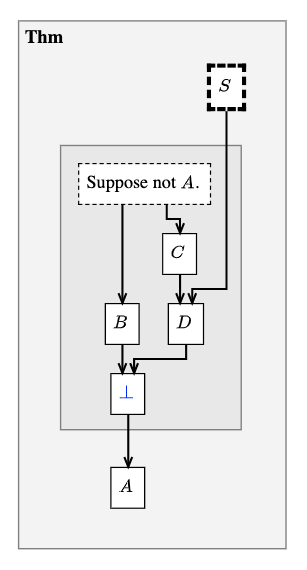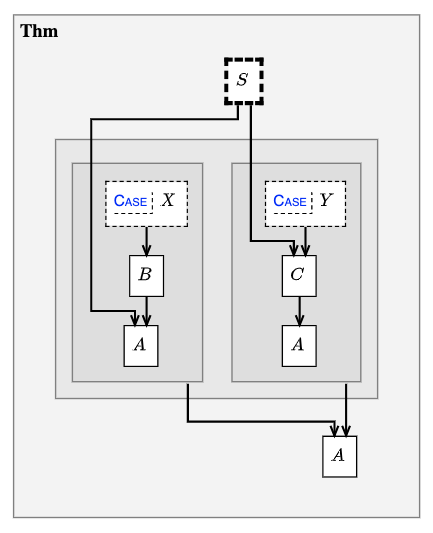Contradictions and Cases#
Proof by contradiction and proof by cases are two common forms for
mathematical proofs. Recalling the general node format
(Listing 52), both of these proof structures are encoded
using node MODIFIERS.
Proof by contradiction#
Proofs by contradiction use the contra modifier.
To encode a proof by contradiction:
Deduce a
flsenode from a set of nodes (often just two) that are mutually contradictory.Link the
flsenode to asuppnode using thecontramodifier.
Example:
deduc Thm {
supp S {
sy="$S$"
}
asrt A {
sy="$A$"
}
meson="Suppose S. Then A."
}
deduc Pf of Thm.A {
supp T {
en="Suppose not $A$."
}
asrt B {
sy="$B$"
}
asrt C {
sy="$C$"
}
asrt D {
sy="$D$"
}
flse F contra T {}
meson = "
Suppose T. Then B and C. From C get D, using Thm.S, hence F, by B.
Therefore Thm.A.
"
}

Fig. 20 A proof by contradiction#
When a proof is displayed in PISE, the contra modifier activates
the “up tack” or falsum symbol on the flse node, so that hovering
highlights the contradicted supp node, and clicking brings it on screen.
Proof by cases#
Proofs by cases use the versus modifier.
To encode a proof by cases:
Use a set of
subdeducnodes, one for each case.Start each
subdeducwith asuppnode, indicating the assumption that defines the case.On one of these
suppnodes, use theversusmodifier to link it with the alternative cases.Deduce the common conclusion, citing each of the
subdeducnodes as reason.
Example:
deduc Thm {
supp S {
sy="$S$"
}
asrt A {
sy="$A$"
}
meson="Suppose S. Then A."
}
deduc Pf of Thm.A {
subdeduc caseX {
supp X {
sy="$X$"
}
asrt B {
sy="$B$"
}
asrt A {
sy="$A$"
}
meson = "Suppose X. Then B, hence A, by Thm.S."
}
subdeduc caseY {
supp Y versus caseX.X {
sy="$Y$"
}
asrt C {
sy="$C$"
}
asrt A {
sy="$A$"
}
meson = "Suppose Y. Then C by Thm.S, hence A."
}
meson = "Thm.A by caseX and caseY."
}

Fig. 21 A proof by cases#
When a proof is displayed in PISE, the versus modifier adds a “CASE” label
to each of the supp nodes that define the cases. The “CASE” label is
activated, so that hovering highlights the case supp nodes, and clicking
brings them on screen.
Using auxiliary deducs#
It is often a good idea to write skeletal proofs in each subdeduc node, while writing a separate deduc to fill in the argument, so that the subdeduc can be expanded and collapsed.
An example of this technique can be seen in a proof by cases, each part of which is a proof by contradiction, in the proof of FLT for regular primes, from Hilbert’s Zahlbericht.